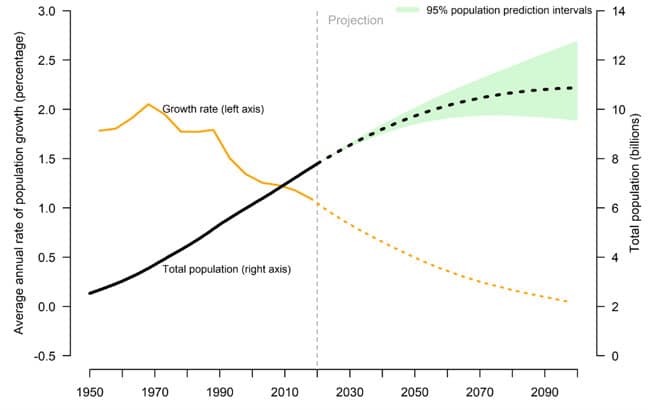Global forecast sets out population trends through 2100
An important indicator of global trends comes from the United Nations Population Division, which releases rich modelling data every two to three years. The latest forecasts, published in June 2019, set out the UN’s projections through the year 2100 and they carry some important implications for international educators.
First and foremost, the world’s population continues to grow but at a slower rate than any other time since 1950. Indeed, as the following chart reflects, the global growth rate has been falling steadily since about 1970.
Even so, the world’s population reached 7.7 billion by mid-2019, which works out to one billion more people than 2007 and two billion more since 1994. Looking ahead, the UN projects that the population will reach 8.5 billion by 2030, nearly 10 billion by 2050, and then 11 billion at the turn of the century.

Another important observation that can be drawn from the UN forecasts is that a relatively small number of countries will account for much of this projected growth. In fact, nine countries will make up more than half of the expected gains through 2050. The largest population increases during that period will come from India, Nigeria, Pakistan, the Democratic Republic of the Congo, Ethiopia, Tanzania, Indonesia, Egypt, and the United States.
The UN’s summary report adds, “Of the additional two billion people who may be added to the global population between 2019 and 2050, 1.05 billion (52%) could be added in countries of sub-Saharan Africa. Another 25% of global population growth is expected to be concentrated in Central and Southern Asia, which is projected to add 505 million people between 2019 and 2050.”
At the same time, many countries will see their populations level off or even decline in the coming decades. The UN notes, “Since 2010, 27 countries or areas have experienced a reduction in the size of their populations of 1% or more. This is caused by low levels of fertility and, in some places, high rates of emigration. Between 2019 and 2050, populations are projected to decrease by 1% or more in 55 countries or areas, of which 26 may see a reduction of at least 10%.”
For many international educators, China will be the most eye-catching entry on this list. Its population is projected to decrease by more than 31 million, or a little over 2%, between 2019 and 2050. With its contrasting increase in population over the same period, India is expected to surpass China as the world’s most populous country sometime around 2027.

Finally, the UN data also highlights the prospect of a significant “demographic dividend” for a number of countries with large and growing working-age populations. In these countries, the working-age cohorts – of people aged 25 to 64 – are growing faster than all other age groups, which in turn opens the door for a period of relatively rapid economic expansion.
This pattern applies for most countries in sub-Saharan Africa, a region which the UN defines as all African states that are fully or partially located south of the Sahara (put another way, the term is also used to make a distinction between North Africa and the rest of the African continent). The UN also projects burgeoning working-age populations for parts of Asia, Latin America, and the Caribbean.
In all such countries, increased investment in education – by governments but also by individuals and families – will be a key factor in realising the full value of this demographic opportunity.
For additional background, please see:


















